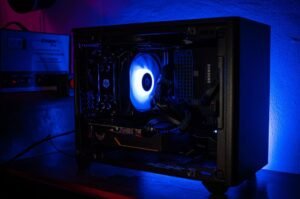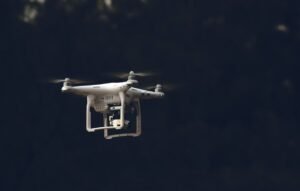Neural Network in AI
Artificial Intelligence (AI) has revolutionized the way computers perform tasks by enabling them to learn and make decisions like humans. One of the key technologies driving these advancements is Neural Networks. Neural networks are computer systems inspired by the structure and functioning of the human brain, allowing machines to recognize patterns, process complex data, and improve their performance over time.
Key Takeaways:
- Neural networks enable machines to learn and make decisions like humans.
- They are inspired by the structure and functioning of the human brain.
- Neural networks can recognize patterns, process complex data, and improve performance.
How Neural Networks Work
Neural networks consist of interconnected nodes, called artificial neurons or perceptrons, organized in layers. Each neuron takes inputs, performs calculations on them, and produces an output. These outputs can then be sent as inputs to other neurons, creating a network-like structure.
One interesting aspect of neural networks is their ability to learn from training data. By adjusting the weights assigned to inputs, neural networks can optimize their performance, making accurate predictions or classifications.
Types of Neural Networks
- Feedforward Neural Networks: The most common type where information flows only in one direction, from input to output. These networks are used for pattern recognition and regression.
- Recurrent Neural Networks (RNNs): These networks allow information to flow in cycles, making them suitable for tasks involving sequence data or time series analysis.
- Convolutional Neural Networks (CNNs): Designed specifically for image recognition and processing, CNNs are built to automatically detect patterns and features in images.
Applications of Neural Networks
Neural networks have found applications in various fields, ranging from healthcare to finance and entertainment. Here are a few notable use cases:
- Medical Diagnosis: Neural networks can analyze medical images, identify diseases, and assist doctors in diagnosing patients.
- Financial Forecasting: Neural networks can analyze vast amounts of financial data and make predictions about stock prices or market trends.
- Speech Recognition: Neural networks power voice assistants and speech recognition systems that understand and respond to human speech.
Neural Network Advancements
| Year | Advancement |
|---|---|
| 1943 | First conceptualization of neural networks by Warren McCulloch and Walter Pitts. |
| 1958 | Development of the Perceptron algorithm by Frank Rosenblatt, an early type of neural network. |
Over the years, neural networks have experienced significant advancements, leading to improved performance and new architectures. One such notable advancement is the invention of the backpropagation algorithm in the 1980s, which enhanced the training process of neural networks. Today, with the advent of deep learning and increased computational power, neural networks are achieving remarkable results in various domains.
Challenges and Future of Neural Networks
While neural networks have proven their effectiveness, they are not without challenges. Some of the key hurdles include the need for large amounts of training data, computational requirements, and interpretability concerns. However, ongoing research and advancements continue to address these challenges and push the boundaries of what neural networks can achieve.
As AI continues to evolve, the future of neural networks looks promising. Researchers are exploring advanced architectures, such as spiking neural networks inspired by biological neurons. This will likely lead to even more sophisticated AI systems capable of tackling complex tasks.
Conclusion
Neural networks have transformed AI by enabling machines to learn from data and make intelligent decisions. With their ability to recognize patterns, process complex information, and improve performance over time, neural networks have found applications in various industries. As ongoing research and advancements push the boundaries of this technology, the future of neural networks looks bright.

Common Misconceptions
Misconception 1: Neural Networks are the same as the human brain
One common misconception is that neural networks in artificial intelligence (AI) function exactly like the human brain. While neural networks are inspired by the brain’s structure and functioning, they are simplified mathematical models and not actual brain simulations.
- Neural networks are based on mathematical algorithms.
- The human brain is much more complex and adaptable compared to artificial neural networks.
- Neural networks lack emotions, intuition, and consciousness, which are characteristics of the human brain.
Misconception 2: Neural Networks are infallible and always produce accurate results
Another common misconception is that neural networks are infallible and always produce accurate results. While neural networks are powerful tools for processing and analyzing large amounts of data, they are still prone to errors and can produce incorrect outputs.
- Neural networks can be affected by noisy or incomplete data, leading to inaccurate predictions.
- They may overfit the training data and generalize poorly to unseen data.
- Improper training or parameter tuning can result in suboptimal performance of neural networks.
Misconception 3: Neural Networks can replace human intelligence and jobs
There is a misconception that neural networks can fully replicate human intelligence and eventually replace human jobs. While neural networks can perform certain tasks more efficiently and accurately than humans, they still lack the broader cognitive abilities and creativity possessed by humans.
- Humans possess complex problem-solving abilities that neural networks cannot fully emulate.
- Certain jobs, such as those involving empathy, creativity, and critical thinking, require human involvement.
- Neural networks are tools that can augment human intelligence and assist in decision-making, but they cannot replace human intelligence entirely.
Misconception 4: Neural Networks always require large amounts of training data
Some people believe that neural networks always require massive amounts of training data to be effective. While it is true that data is crucial for training neural networks, the amount of data required can vary depending on the complexity of the task and the architecture of the neural network.
- Simple tasks may require minimal training data, while complex tasks may need more extensive datasets.
- Data quality and diversity are often more important than the sheer volume of data for effective training.
- Techniques like transfer learning can enable neural networks to learn from smaller datasets or leverage pre-trained models.
Misconception 5: Neural Networks are only useful for pattern recognition
Many people wrongly assume that neural networks are only useful for pattern recognition tasks. While neural networks excel in tasks like image and speech recognition, they have diverse applications beyond pattern recognition.
- Neural networks can be employed in natural language processing to understand and generate human language.
- They can be utilized in time-series forecasting and predictions based on temporal data.
- Reinforcement learning, a subset of neural networks, is used in decision-making and control systems.

Introduction
Neural networks have revolutionized the field of artificial intelligence (AI) by simulating the human brain’s ability to learn and make decisions. These complex models consist of interconnected nodes that process and transmit information, enabling AI systems to recognize patterns, analyze data, and make intelligent predictions. In this article, we delve into the fascinating world of neural networks and present ten intriguing tables that highlight various aspects of their application in AI.
Table: Evolution of Neural Networks
This table showcases the milestones in the development of neural networks, illustrating how these models have evolved over the years.
| Year | Development |
|---|---|
| 1956 | Creation of the first artificial neuron |
| 1986 | Introduction of the backpropagation algorithm |
| 2012 | AlexNet wins the ImageNet Large Scale Visual Recognition Challenge |
| 2018 | OpenAI’s GPT-2 model generates realistic text |
Table: Neural Network Applications
Discover the diverse range of applications where neural networks have made significant contributions, from image recognition to natural language processing.
| Application | Description |
|---|---|
| Speech Recognition | Converting spoken words into written text |
| Medical Diagnosis | Detecting diseases based on symptoms and medical records |
| Autonomous Vehicles | Enabling cars to navigate and make driving decisions |
| Financial Market Analysis | Predicting stock prices and detecting market trends |
Table: Types of Neural Networks
Explore the various types of neural networks tailored for different tasks, each employing distinct architectures and algorithms.
| Neural Network Type | Description |
|---|---|
| Convolutional Neural Network (CNN) | Designed for image and video analysis |
| Recurrent Neural Network (RNN) | Well-suited for sequence data analysis |
| Generative Adversarial Network (GAN) | Used for creating realistic synthetic data |
| Long Short-Term Memory (LSTM) Network | Effective in handling sequential data and time series |
Table: Advantages of Neural Networks
Explore the compelling advantages that neural networks offer, making them indispensable in modern AI systems.
| Advantage | Description |
|---|---|
| Pattern Recognition | Ability to identify intricate patterns in data |
| Parallel Processing | Simultaneous processing of data for faster analysis |
| Adaptability | Ability to learn from new data and update predictions |
| Robustness | Tolerance to noisy or incomplete input data |
Table: Neural Network Training Techniques
Discover the techniques employed to train neural networks effectively, ensuring accurate predictions and optimal performance.
| Training Technique | Description |
|---|---|
| Supervised Learning | Training using labeled input-output pairs |
| Unsupervised Learning | Extracting patterns from unlabeled data |
| Reinforcement Learning | Learning through interaction with an environment |
| Transfer Learning | Applying knowledge from one task to another |
Table: Neural Network Performance Metrics
Examine the metrics used to evaluate the performance of neural networks, ensuring their effectiveness and reliability in real-world applications.
| Performance Metric | Description |
|---|---|
| Accuracy | The proportion of correctly classified instances |
| Precision | The ratio of true positives to the total predicted positives |
| Recall | The ratio of true positives to the total actual positives |
| F1 Score | The harmonic mean of precision and recall |
Table: Limitations of Neural Networks
Uncover the limitations of neural networks, highlighting some challenges that researchers aim to overcome to further enhance their capabilities.
| Limitation | Description |
|---|---|
| Data Dependency | Heavy reliance on large amounts of labeled data |
| Interpretability | Difficulty in understanding the decision-making process |
| Computational Requirements | High computational power and memory demands |
| Overfitting | Model becoming too specialized to training data |
Table: Neural Networks in Popular AI Systems
Explore some well-known AI systems that harness the power of neural networks, revolutionizing industries and daily life.
| AI System | Application |
|---|---|
| DeepMind’s AlphaGo | Defeating world champion Go players |
| IBM Watson | Natural language processing and question-answering |
| Amazon Alexa | Voice recognition and intelligent personal assistant |
| Tesla Autopilot | Enabling autonomous driving and advanced safety features |
Conclusion
Neural networks have revolutionized the field of artificial intelligence with their ability to learn and make intelligent decisions. From the evolution of these models to their applications in various domains, neural networks have become indispensable in our increasingly AI-driven world. Despite their limitations, ongoing research and advancements seek to tackle these challenges, paving the way for future breakthroughs. With neural networks powering cutting-edge AI systems, the possibilities for innovation and transformative impact continue to expand.
Frequently Asked Questions
Neural Network in AI
What is a neural network?
A neural network is a type of machine learning algorithm inspired by the structure and functionality of the human brain. It consists of interconnected nodes, called neurons, organized into layers. These networks are designed to recognize patterns and relationships in data, enabling them to make predictions or classifications.
How does a neural network work?
A neural network works by taking inputs, applying weights to them, and passing them through activation functions that determine the output of each neuron. The weights and activation functions are adjusted during a training process, where the network learns to optimize its performance by minimizing the difference between its predicted output and the desired output.
What are the different layers in a neural network?
A neural network typically consists of an input layer, one or more hidden layers, and an output layer. The input layer receives the initial data, the hidden layers process the information through the network, and the output layer produces the final result or prediction.
What are the activation functions used in neural networks?
There are various activation functions used, including the sigmoid function, hyperbolic tangent function, and rectified linear unit (ReLU) function. The choice of activation function depends on the type of problem being solved and the desired behavior of the network.
What are the advantages of using neural networks in AI?
Neural networks have several advantages in AI, such as their ability to learn from large amounts of data, their capability to handle complex and non-linear relationships, and their potential to generalize well to unseen inputs. They can also learn to recognize patterns that may be difficult for traditional algorithms to detect.
What are the limitations of neural networks?
Neural networks can be computationally expensive to train and require large amounts of labeled data. They can also suffer from overfitting, where the network becomes too specialized to the training data and performs poorly on new data. Additionally, the interpretability of neural network decisions can be challenging since they are often considered black-box models.
What are some popular applications of neural networks?
Neural networks have found applications in various fields, such as image and speech recognition, natural language processing, recommender systems, financial forecasting, and medical diagnosis. They have been successfully used for tasks like object detection, sentiment analysis, language translation, and stock market prediction.
Can neural networks be used for deep learning?
Yes, neural networks can be used for deep learning. Deep learning refers to networks with several hidden layers, allowing them to learn hierarchical representations of data. Deep neural networks are particularly effective in tasks such as computer vision, speech recognition, and natural language understanding.
Are there any alternatives to neural networks in AI?
Yes, there are alternative machine learning algorithms to neural networks, such as decision trees, support vector machines, and Bayesian networks. These algorithms have their own strengths and weaknesses and may be more suitable for certain types of problems or situations with limited data.
What is the future of neural networks in AI?
The future of neural networks in AI looks promising, with ongoing research and advancements. There is increasing interest in developing more efficient neural network architectures, exploring new training algorithms, and addressing challenges such as interpretability and fairness. Neural networks are likely to continue playing a key role in advancing AI technologies and applications.




